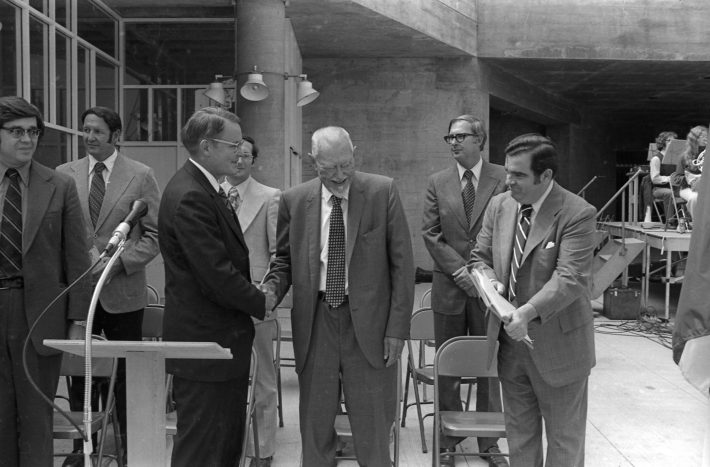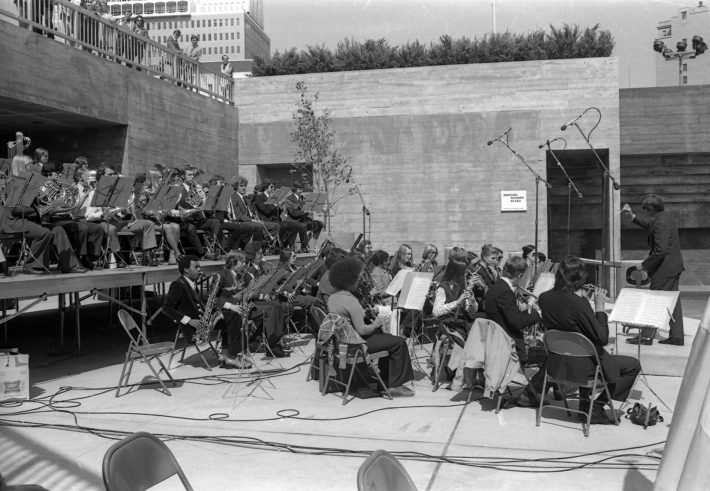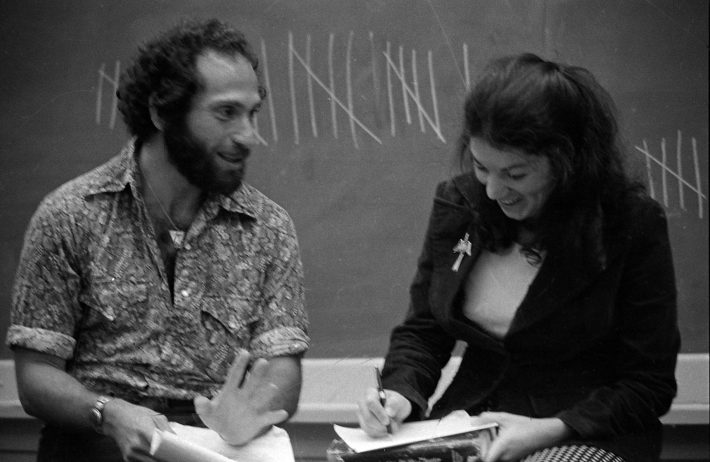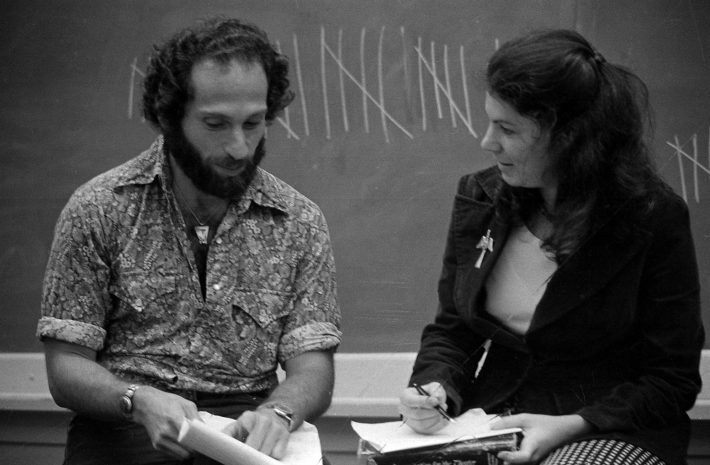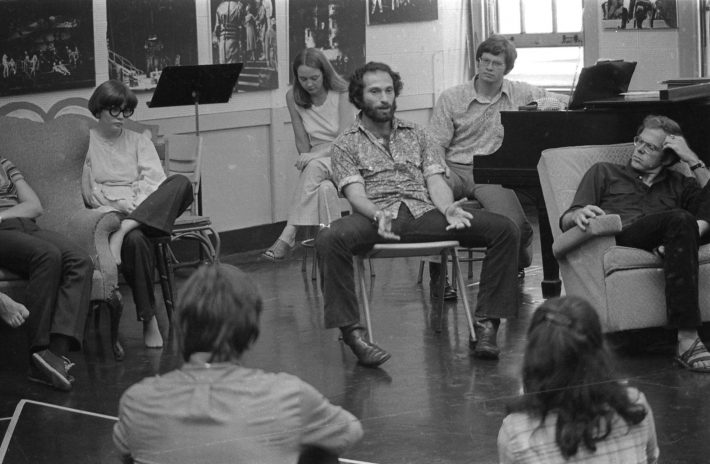Published on Sep 8, 2021
1995: Eastman hosts the third annual Gateways Music Festival
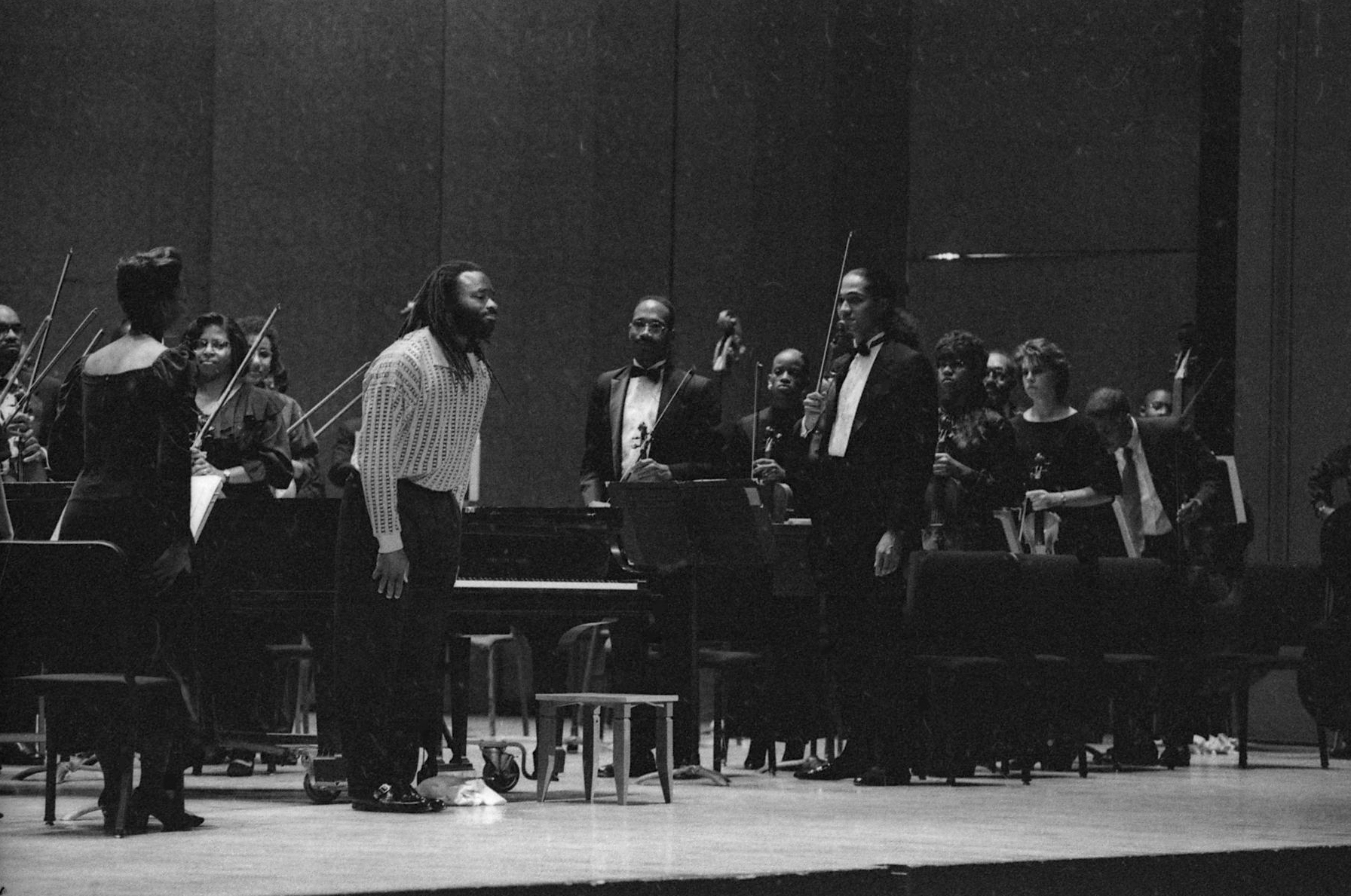
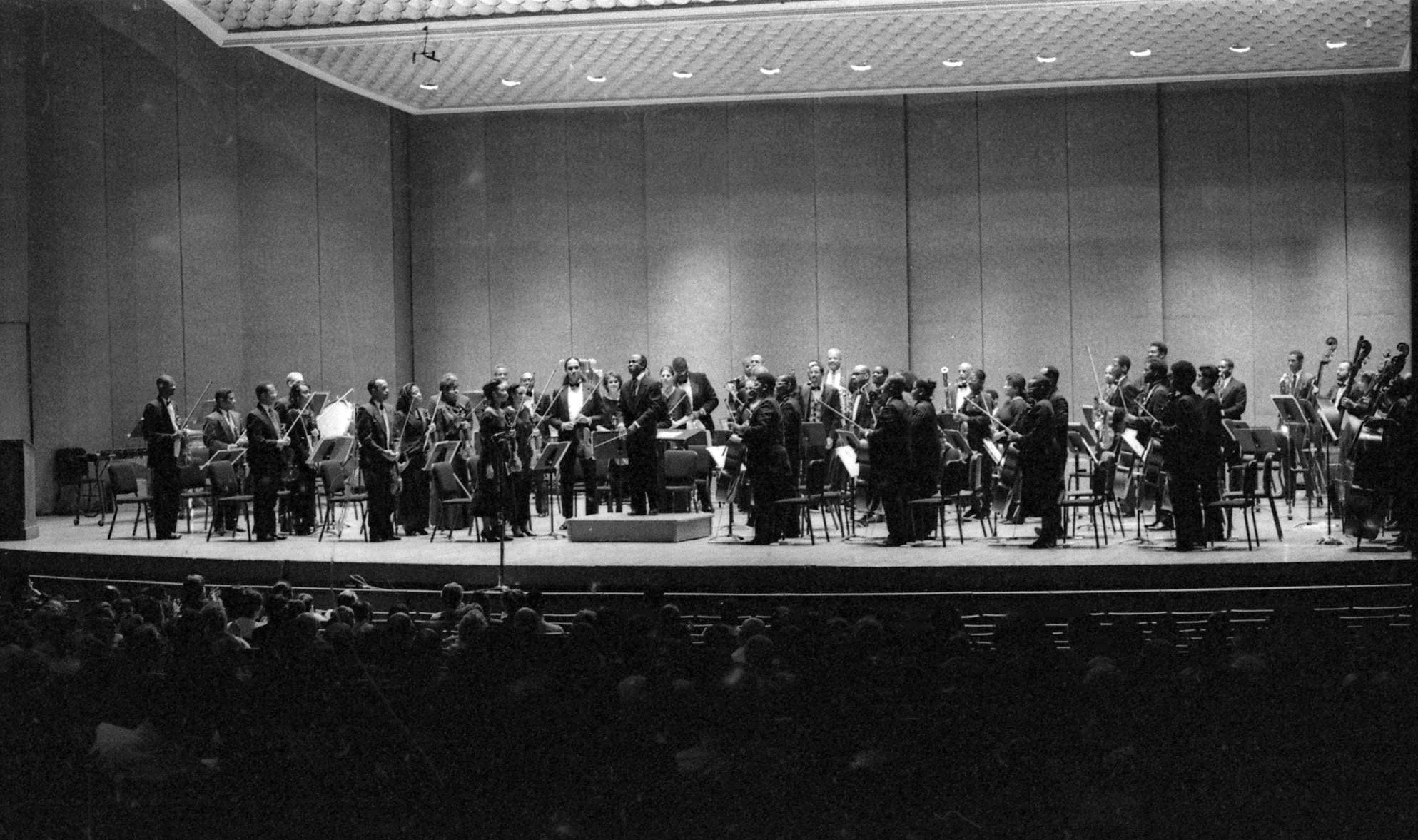
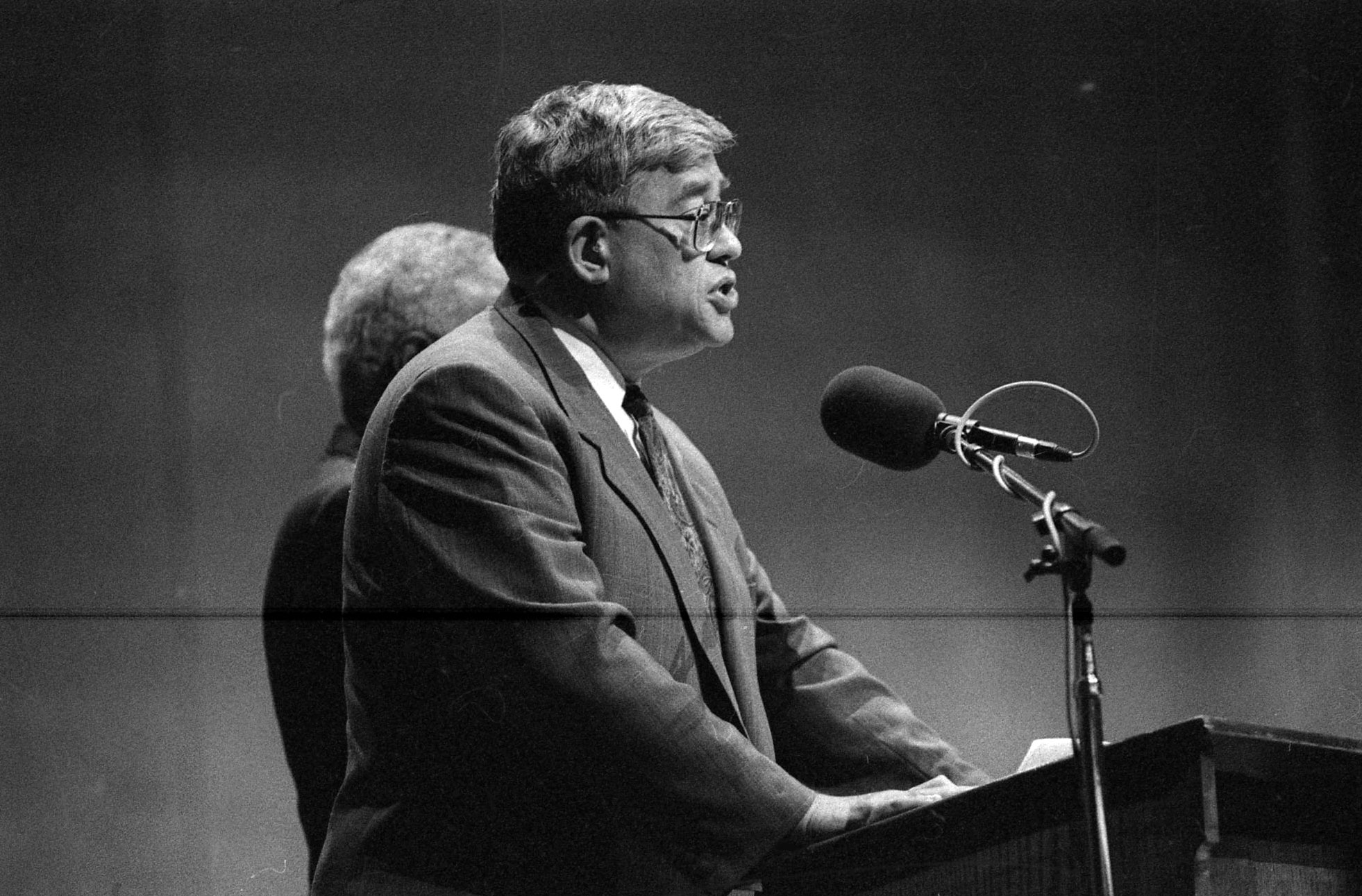
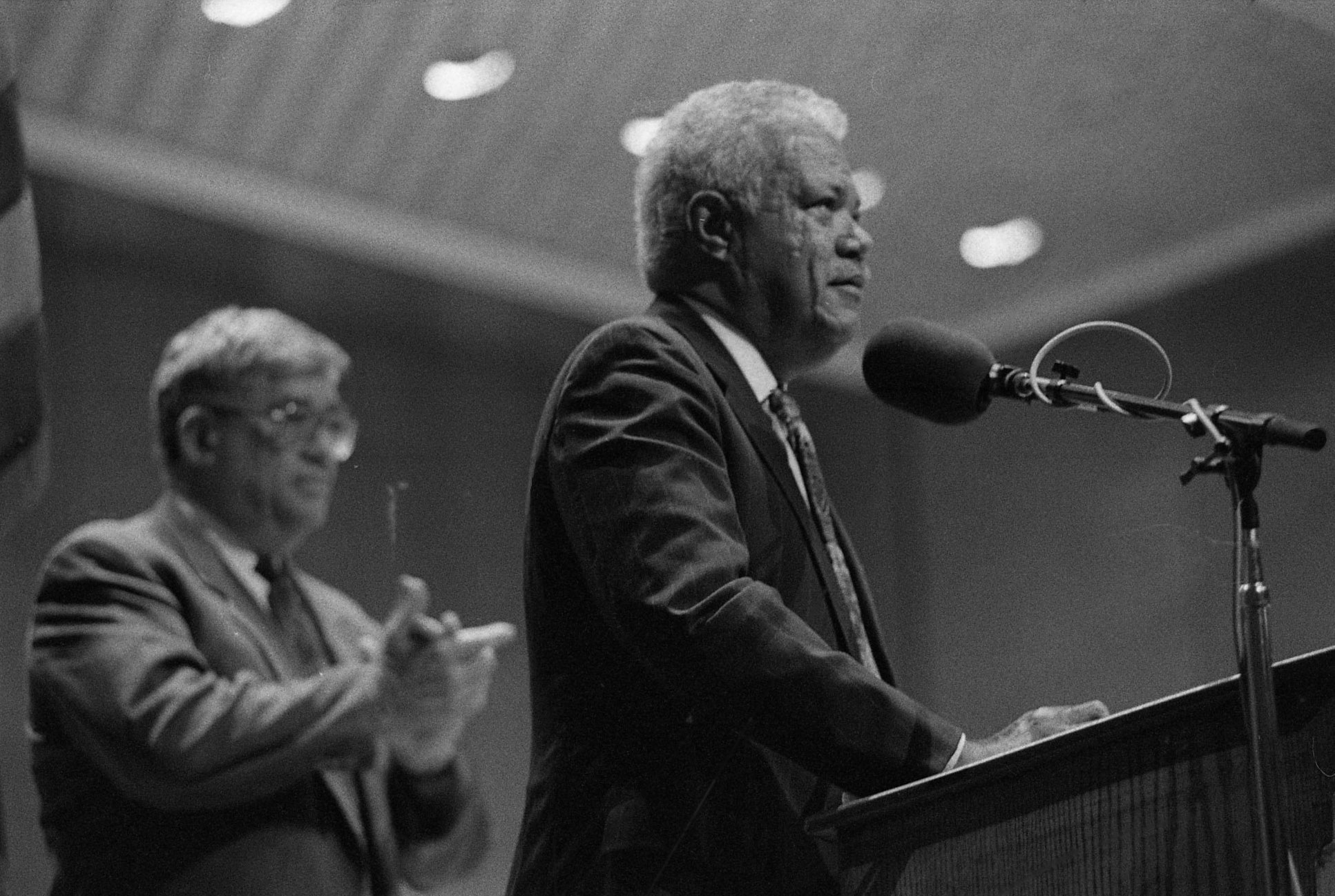
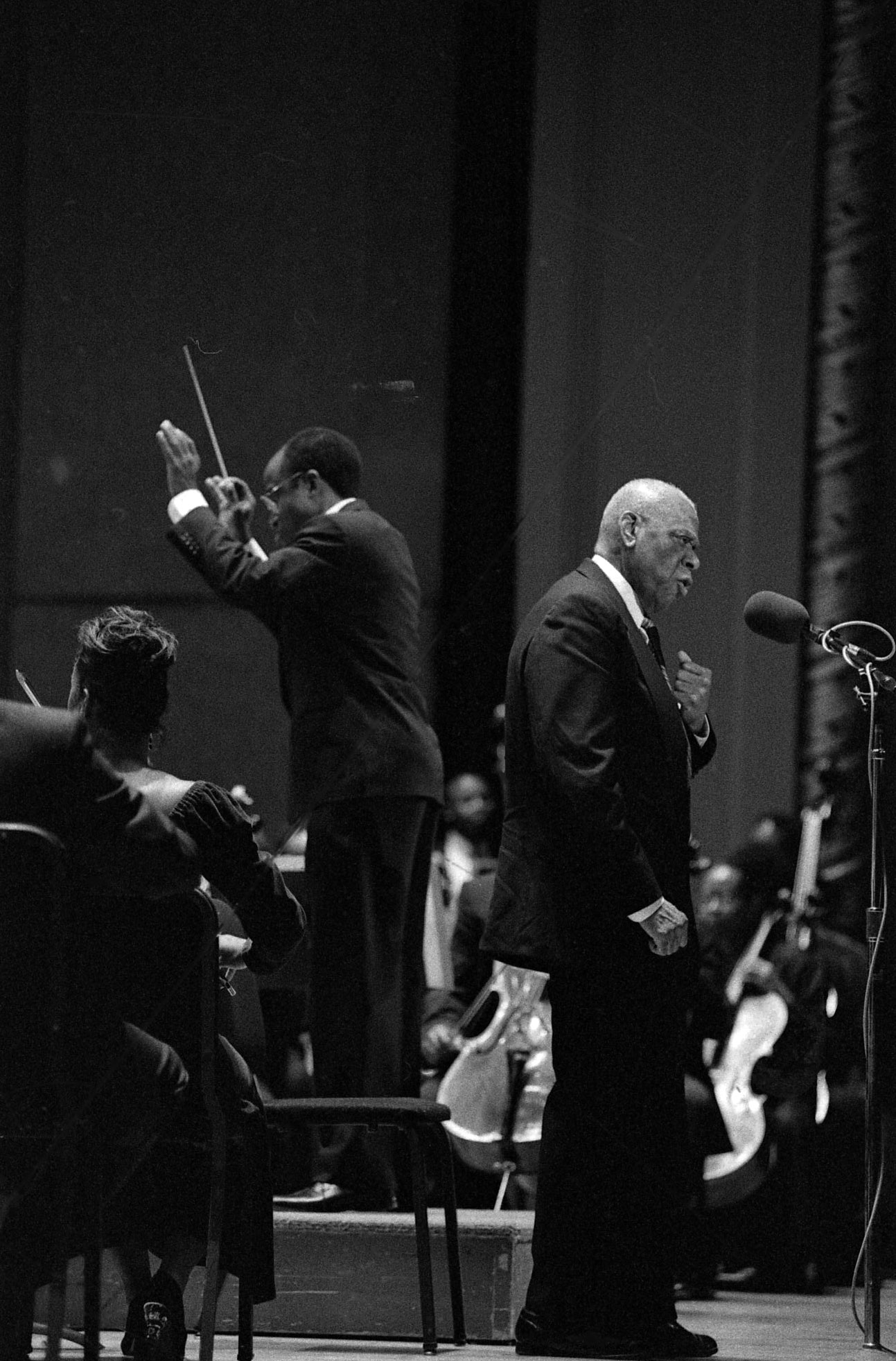 On September 10th, 1995, the third annual Gateways Music Festival concluded with a gala concert in the Eastman Theater, at which the Gateways Festival Orchestra, comprised of 75 African American musicians from across the nation, performed under the direction of three conductors in turn. The Festival had been founded in 1993 by concert pianist Armenta Adams Hummings with the goal of increasing the visibility of musicians of color. Altogether, the 1995 Festival featured five programs—orchestral, chamber, and solo instrumental—led by three different conductors and featuring five soloists. Eastman School Director Robert Freeman addressed the audience from the stage at the opening of the concluding concert, using the occasion to announce that Rochester would henceforth become the Gateways Musical Festival’s permanent site.
On September 10th, 1995, the third annual Gateways Music Festival concluded with a gala concert in the Eastman Theater, at which the Gateways Festival Orchestra, comprised of 75 African American musicians from across the nation, performed under the direction of three conductors in turn. The Festival had been founded in 1993 by concert pianist Armenta Adams Hummings with the goal of increasing the visibility of musicians of color. Altogether, the 1995 Festival featured five programs—orchestral, chamber, and solo instrumental—led by three different conductors and featuring five soloists. Eastman School Director Robert Freeman addressed the audience from the stage at the opening of the concluding concert, using the occasion to announce that Rochester would henceforth become the Gateways Musical Festival’s permanent site.
The Festival had opened on September 8th with a chamber music concert in Kilbourn Hall; the program had included Lyric for Strings by Eastman alumnus and Pulitzer Prize laureate George Walker, DMA. In addition, Michael Morgan conducted a chamber orchestra in Bach’s Brandenburg Concerto no. 1. On September 9th, two performances took place in Kilbourn Hall: an afternoon piano recital in which the Rev. Charles Walker and Mr. Roy Eaton shared the bill, and an evening chamber music concert featuring a mixed bill of performers. The Anderson Quartet, whose members were all Eastman School alumni, gave the premiere performance of Alvin Singleton’s Somehow We Can (1994), which had been inspired by the poem of the same title by conductor James DePreist, nephew of contralto Marian Anderson, after whom the Quartet was named. Also appearing that evening, cellist Owen Young and pianist Joy Michele Cline so impressed the audience with their performance of Rachmaninoff’s Cello Sonata in G minor that the Eastman School immediately engaged them to appear in the Kilbourn Concert series in the 1996-97 season. (The program for their return engagement on October 8th, 1996 would include the Sonata for Cello and Piano by Eastman’s own George Walker.)
Festival programming continued on September 10th with a piano monster concert in the Eastman Theater, which was opened with solo works announced from the stage by five pianists performing in turn. Thereafter, the concert concluded with Louis Moreau Gottschalk’s arrangement of Rossini’s William Tell Overture, scored for ten pianos (!) with orchestra, all conducted by Awadagin Pratt. The Festival concluded that evening with the Festival Orchestra concert in the Eastman Theater. The concert was opened with remarks by the Honorable William Johnson, Mayor of Rochester, and by Dr. Freeman. Mr. Johnson was quoted in the Rochester Times-Union the following day as having told the audience, “It does my heart good if I see one or two African American musicians in an orchestra. But my heart is beating overtime tonight,” he said as he gestured towards the 75-piece Festival Orchestra. The concert featured three different conductors, each leading the Festival Orchestra in turn: Michael Morgan, Alfred Duckett, and Awadagin Pratt, who doubled as conductor and soloist in Beethoven’s Piano Concerto no. 3. Pianist Richard Fields was soloist in William Grant Still’s Kaintuck for piano and orchestra, which had received its world premiere performance in the Eastman Theater under Howard Hanson’s direction on January 16th, 1936. The concluding work on the program was A Lincoln Portrait by Aaron Copland, with Eastman’s very own William Warfield, BM ’42, appearing as the narrator.
►Photos by Louis Ouzer, master negative nos. R4160-2, 14, 15, 26, 34, 36; R4161-19, 31, 36.
Background:
“Black Musicians Shine at Gateways Festival” in Eastman Notes, December 1995 issue, pages 1 and 10; reprinted from the Rochester Times-Union, September 11th, 1995.
1975: Howard Hanson Plaza in Manhattan Square Park
“Plaza dedicated to Howard Hanson” by Michael Walsh, Rochester Democrat & Chronicle, September 11, 1975.
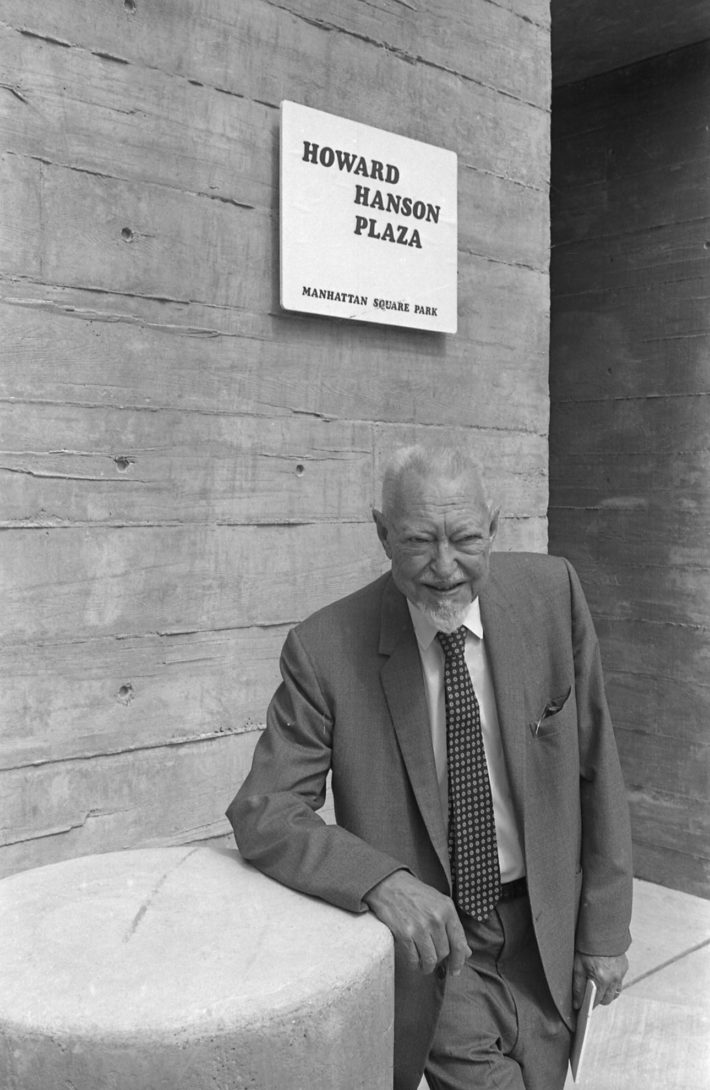
“Howard Hanson Week: amphitheater named Howard Hanson Plaza,” Notes from Eastman¸ vol. 9, no. 2 (June, 1975), page 3.
Retired Eastman School Director Howard Hanson (served 1924-64) was honored on September 10th, 1975 by the dedication of Howard Hanson Plaza, an outdoor amphitheater in Manhattan Square Park in downtown Rochester. (Today the park is known as Martin Luther King, Jr. Memorial Park.) In the week beginning Monday, September 8th, the then-brand-new park at the corner of Court and Chestnut Streets—which amounted to a major part of Rochester’s urban renewal in the 1970s—was formally opened and dedicated with a week-long program of activities. The dedication of both the park and Howard Hanson Plaza took place on September 10th. Announcement of the naming of Howard Hanson Plaza had been made earlier in the year, when the City of Rochester had proclaimed Howard Hanson Week in the week of April 28th/May 2nd.
Altogether, the plaza, constructed beneath street level and consisting of several levels of poured concrete, consisted of an amphitheater for outdoor performances and also a fountain with pools and waterfalls, through which filtered, chlorinated water was directed; in a unique twist, wading in the fountain was encouraged. In expressing his gratitude, Dr. Hanson was quoted as saying, “I am a little overwhelmed. It’s more unusual to have a public area be named after someone in the arts. You don’t find many buildings or places named after musicians or novelists or poets. I think the big thing is generally sports. I am flattered that someone thought of it.”
The dignitaries who spoke at the plaza’s daytime dedication were Rochester Mayor Tom Ryan, UR President Robert Sproull, and Eastman School Director Robert Freeman. The audience was a mix of local businesspersons, clergypersons, elected public officials, Eastman School faculty members and students, local citizens, and workmen in hard hats who had been contracted for the formation of the park. The Eastman Wind Ensemble performed Hanson’s Dies Natalis, conducted by Dr. Hanson himself, and also the Festive Overture by Shostakovich (arranged by Donald Hunsberger) and the American Festival Overture by Joseph Wilcox Jenkins. In the evening, Eastman students performed a longer program on the plaza.
►Photos by Louis Ouzer, master negative nos. R2079-16, 17; R2080-7A, 10A, 15A; R2081-8; R2083-24, 25, 27.
1976: Richard Pearlman meets with Eastman students at the start of his first semester
Background: Eastman School Programs, 1976-77, in the Eastman School of Music Archive, Ruth T. Watanabe Special Collections, Sibley Music Library.
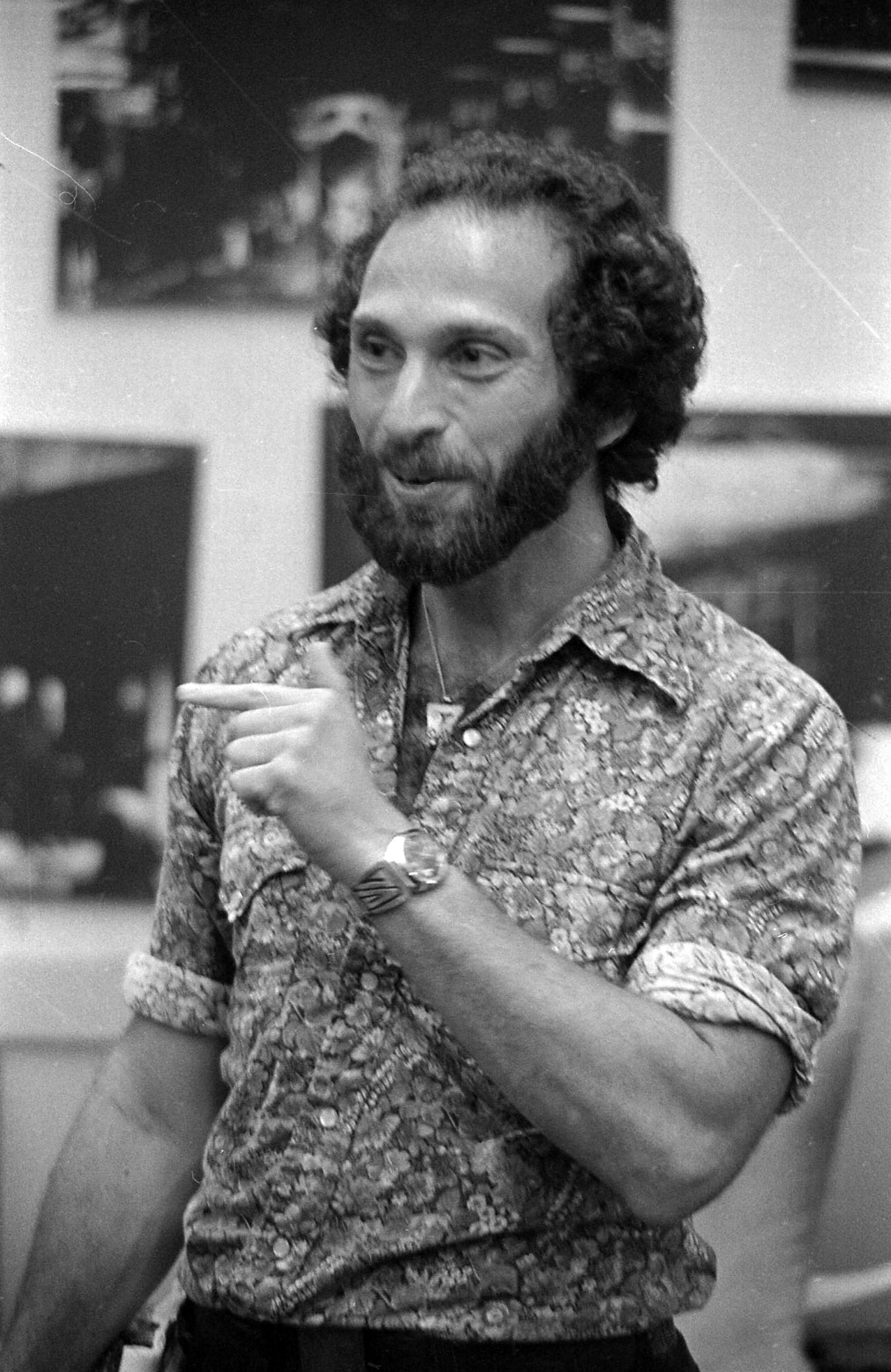 On September 8th, 1976, newly appointed Associate Professor of Opera and Dramatic Director of Eastman Opera Theater Richard Pearlman (served 1976-95) was photographed working with voice and opera students, apparently in a session of either Opera 215 (Workshop) or Opera 401 (Seminar). In the academic year year just then beginning, Eastman Opera Theater would mount three productions: on November 18th and 19th, Capriccio by Richard Strauss, directed by Frédéric O’Brady and performed in the Eastman Theater; on February 26th and 27th, Transformations by Conrad Susa, after the book of poetry of the same title by Anne Sexton, directed by Mr. Pearlman and performed in Annex I; and on April 23rd and 24th, The Magic Flute by Mozart, in W. H. Auden’s translation, directed by Mr. Pearlman and performed in room 804 of Annex II.
On September 8th, 1976, newly appointed Associate Professor of Opera and Dramatic Director of Eastman Opera Theater Richard Pearlman (served 1976-95) was photographed working with voice and opera students, apparently in a session of either Opera 215 (Workshop) or Opera 401 (Seminar). In the academic year year just then beginning, Eastman Opera Theater would mount three productions: on November 18th and 19th, Capriccio by Richard Strauss, directed by Frédéric O’Brady and performed in the Eastman Theater; on February 26th and 27th, Transformations by Conrad Susa, after the book of poetry of the same title by Anne Sexton, directed by Mr. Pearlman and performed in Annex I; and on April 23rd and 24th, The Magic Flute by Mozart, in W. H. Auden’s translation, directed by Mr. Pearlman and performed in room 804 of Annex II.
Mr. Pearlman’s reputation was such that he was frequently in demand to direct productions elsewhere, hence it was not uncommon for EOT productions to be directed and/or produced by guests.
►Photos by Louis Ouzer, master negative nos. R2222-5A, 7A, 19A, 35A, 26A, 32A.
Background: Eastman School Programs, 1976-77, in the Eastman School of Music Archive, Ruth T. Watanabe Special Collections, Sibley Music Library.
1985: Wynton Marsalis records “Carnaval!” with the Eastman Wind Ensemble
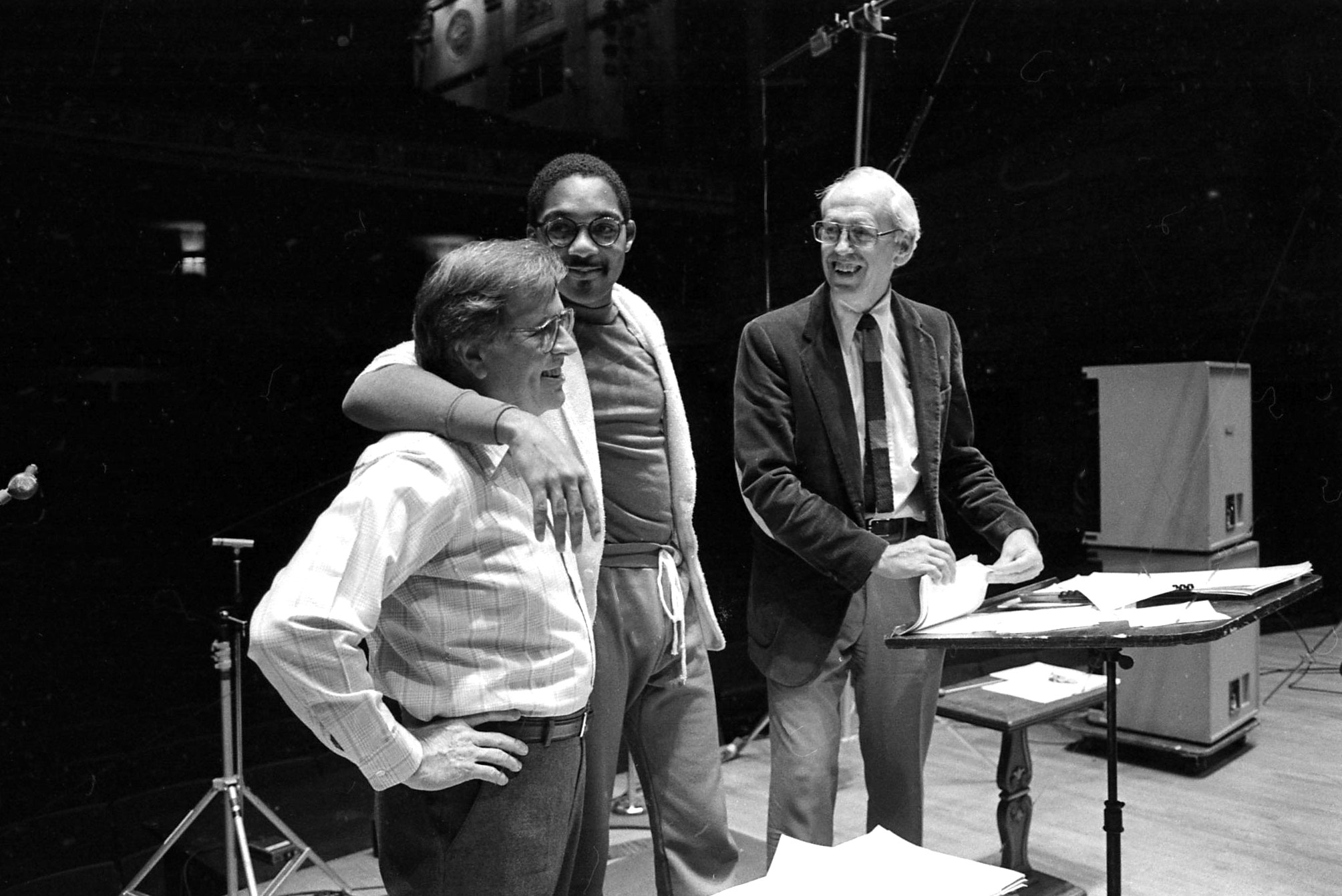
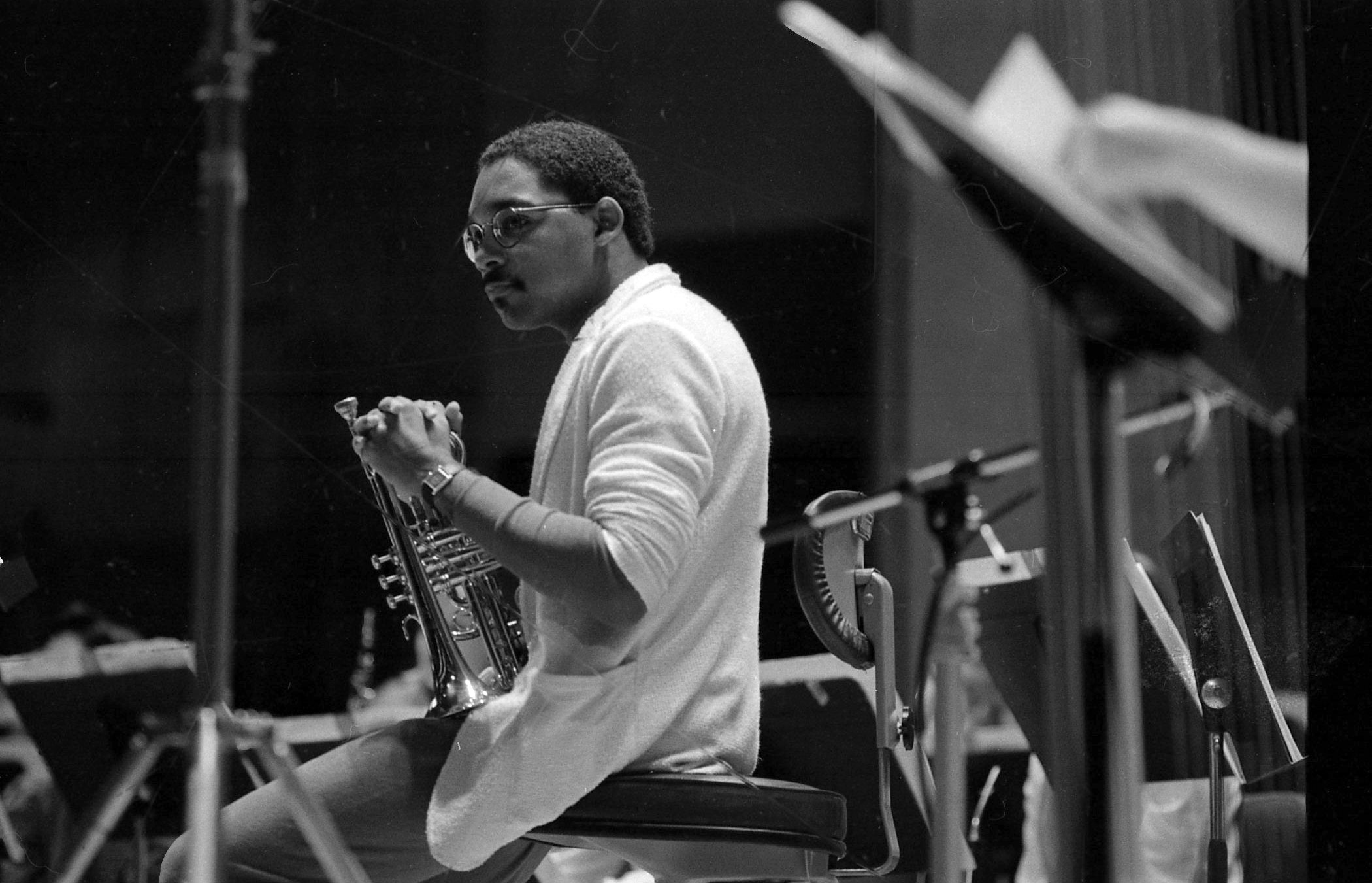
“Wynton Marsalis records with Eastman Wind Ensemble” Eastman Notes, vol. 18, no. 2 (October 1985), page 3.
The Wind Ensemble and its Repertoire: Essays on the Fortieth Anniversary of the Eastman Wind Ensemble. Edited by Frank J. Cipolla & Donald Hunsberger. University of Rochester Press, 1994.
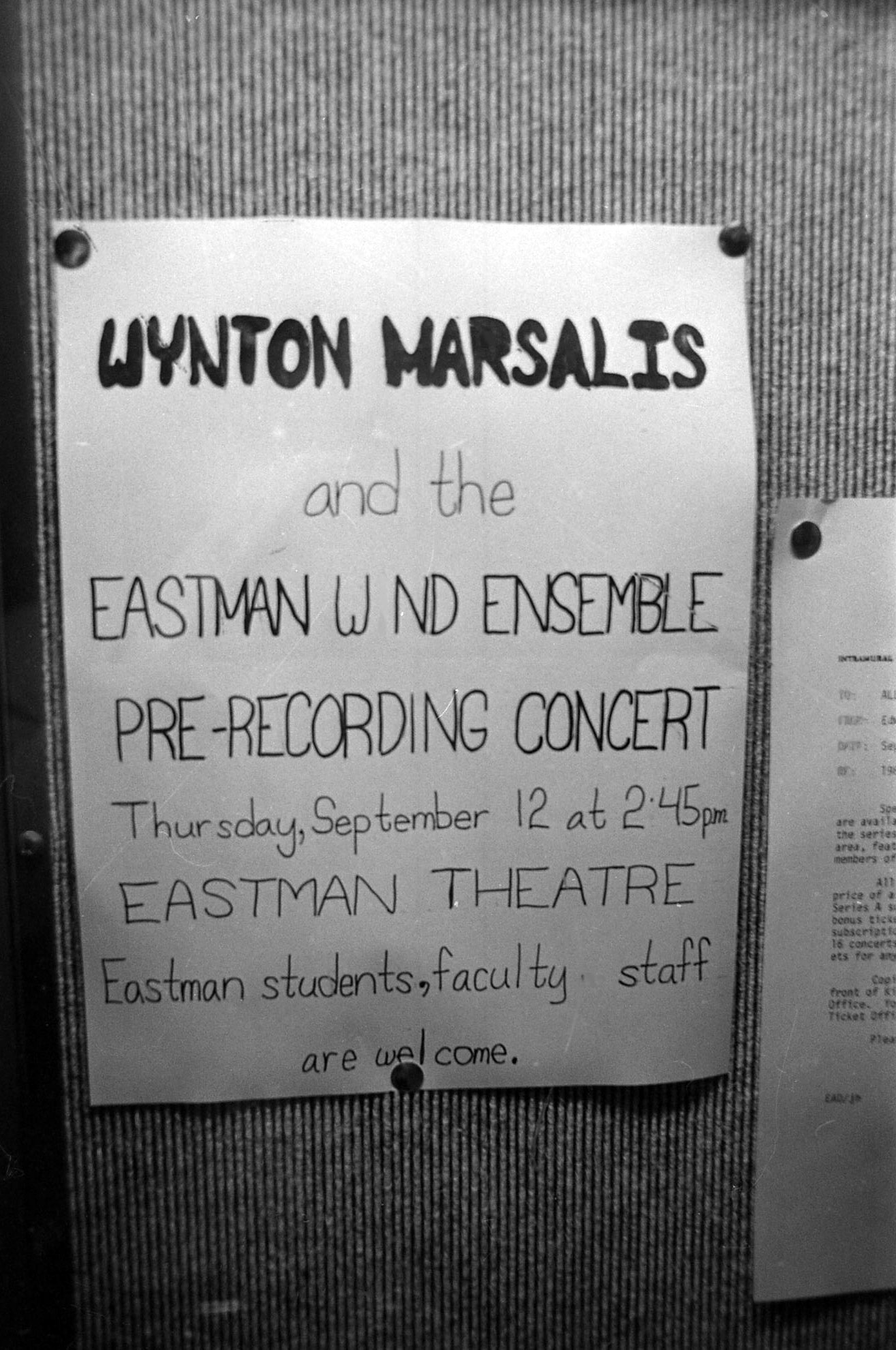 On September 12th, 1985, the Eastman Wind Ensemble and featured soloist Wynton Marsalis collaborated in recording sessions for what would become the album Carnaval! on the CBS Masterworks label. Mr. Marsalis had first been introduced to the Eastman School audience when he appeared as soloist with the Eastman Jazz Ensemble (Rayburn Wright, director) on March 14th, 1984. The Carnaval! recording featured turn-of-the-century (i.e. the 19th/20th centuries) solo cornet showpieces by such legends as J. B. Arban, Hermann Bellstedt, and Herbert L. Clarke, all scored with instrumental accompaniments arranged by Donald Hunsberger. The leadership at CBS Masterworks demonstrated their confidence in the EWE/Marsalis project by investing in transporting their recording team and equipment to Rochester and hiring the 48 EWE members at union scale for the duration of the recording sessions.
On September 12th, 1985, the Eastman Wind Ensemble and featured soloist Wynton Marsalis collaborated in recording sessions for what would become the album Carnaval! on the CBS Masterworks label. Mr. Marsalis had first been introduced to the Eastman School audience when he appeared as soloist with the Eastman Jazz Ensemble (Rayburn Wright, director) on March 14th, 1984. The Carnaval! recording featured turn-of-the-century (i.e. the 19th/20th centuries) solo cornet showpieces by such legends as J. B. Arban, Hermann Bellstedt, and Herbert L. Clarke, all scored with instrumental accompaniments arranged by Donald Hunsberger. The leadership at CBS Masterworks demonstrated their confidence in the EWE/Marsalis project by investing in transporting their recording team and equipment to Rochester and hiring the 48 EWE members at union scale for the duration of the recording sessions.
Apart from the recording project, the Carnaval! repertory was showcased by the EWE and Mr. Marsalis during a tour of cities in the Eastern U.S. and Canada. Over a two-week period, the assembled forces performed in Burlington, Vermont; Montréal; Toronto; London, Ontario; Schenectady; Kingston, Ontario; Boston; Lewisburg, Pennsylvania; Philadelphia; Washington, D.C.; Elmira, New York; New York City; and then a concluding concert in the Eastman Theater on March 23rd, 1987.
Carnaval! was released in 1987 in three formats: LP album, audio-cassette, and compact disc. In the September 12th, 1987 issue of Billboard, Carnaval! was no. 1 on the Classical chart after having placed on the chart for 23 weeks previously.
►Photos by Louis Ouzer, master negative nos. R3382-3, -18, -29; R3383-22, -24, 27.


